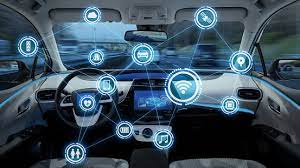Connected Vehicle Data is Driving the Future of Auto Industry

The 21st century we live in is flooded with vehicles of all shapes and sizes that keep the wheel of our economy turning. The automotive landscape today has reached far out from the constraints of mere transportation. It instead serves to industries that hold the potential to create great market value out of data-based services.
So much so that building on the impressive popularity of embedded connectivity in cars, analysts predict US new light-duty vehicles to see up to 90% increase in connected vehicles, while India to sustain 1 in every 4 cars with 5G connectivity, by 2025. With such an accelerated growth, it is estimated that connected cars will represent over 5% of all connected devices, in the same timeframe.
This transition to software has helped the auto sector get rid of its much-unwanted load, in form of analog and device-based data gathering solutions, and enabled dependence on software-as-a-service (SaaS) and subscription businesses. Besides providing a unique customer experience, such services deliver great value to numerous players in the market, and beyond.
Vehicle Data – Connecting the Masses
While transportation has almost always been a decentralized process of enabling travel between two points, the concept of connected vehicles brings in a sense of unification. But putting the interests of the drivers on the centre-stage, connected cars improve the automotive value chain and the whole ecosystem around it.
Software-driven vehicles consist the unique ability to record and share, with a centralized decrypting entity, numerous attributes and parameters that evaluate the driver and vehicle performance, as well as the operational environment. It is this central entity that then unscrambles the vehicle data, that leads to truly personalized driving experiences. This data also boosts advancements in mobility solutions, vehicle services, safety, performance and the overall vehicle design pipeline.
Surrounded by a myriad of vehicles around us, we rarely stop to think about the impacts they might have on our lives, that could change the future as we know it. Connected vehicles stormed the industry with a revolutionary product that targets wide-spread influence, promptly.
Who owns this data?
Including parameters such as real-time location, speed, fuel tank level, vehicle health status, battery status, odometer readings, tire pressure and more, connected car data deals closely with information unique to each vehicle, its operation and the driver, usually based on consent. While end-users or drivers remain the sole owners of this information, the services they consume are delivered on grant of permission for the service provider/OEM to use and share this data, for a range of connected solutions.
Benefits of Connected Car Data
Mobility data acts as a unified solution to most auto industry challenges, with a single source of integration. Here are some top benefits of leveraging the power of connected vehicle data:
- Reduced Dependency – One of the advantages of utilising the power of telematics-based vehicle data is that it eliminates the need to depend on several aftermarket devices, and lets businesses focus on key revenue generating activities.
- Cloud integration – Very often, connected vehicle data is made available to auto businesses through quick cloud integrations and easy APIs, that not only expedite the entire process but also bring in convenience.
- No Onboarding Costs – Service providers do away with tethered data devices, cables, long installation times and high upfront expenses. They experience quick and easy sourcing of data, directly from the OEMs, with optimized CapEx and OpEx.
- Superior Quality Data – Without a doubt, the data collected directly from the source vehicles and their respective OEMs holds information that’s more valuable, simpler and useful for the customers.
- The Power of AI & IoT – While vehicle in itself might not yield much value to auto businesses, it is the hidden significance underneath that catches attention and empowers revolutionary solutions, unlocked through the application of AI and automotive IoT.
Other benefits of connected car data include, but aren’t limited to:
- Easy and quick lifecycle processes, from diagnosis to resolution.
- Standardization of vehicle parameters for all makes and models.
- Enabling data analytics and value-added services to unlock sustainable business activities.
- Insights beyond OBD devices and applications, measuring a variety of attributes.
Why is this data important?
Data thus collected from connected vehicles holds great value for the development and improvement of a wide variety of services in the automotive ecosystem. It plays an important role in influencing the in-car experience, comfort level, maintenance as well as safety of the passengers, and goes a long way in aiding service providers in delivering a fulfilling driving experience. By optimizing the vehicle operation, data paired with automotive IoT is a boon for the future of connectivity in automobiles.
Here is a brief look at how this data affects different industries within the auto sector, to make driving experiences worthwhile.
Fleet Management
Intelligent analysis of connected vehicle data yields greatly to serve the fleet industry. Fleet managers get the unique opportunity to get a bird’s eye view of their entire operations as well as expenditure, all in real-time, with windows for improvement. Connected fleets work in harmony with AI technology to simplify the flow of information and bring any variables in sync, to develop fleet management strategies that nurture growth.
As a result, the effect of AI on fleet management is expected to reduce collisions by 60%, collision costs by 75%, boost performance uptime by 50% and reduce overall fleet costs by up to 40%. By creating a unified front against some of the most pressing challenges faced by fleet managers, connected vehicle technology has successfully brought transparency into driver and consumer needs.
Vehicle data enables fleet managers to:
- Easily monitor fleets in real-time, track live location, prevent thefts and more.
- Automate mundane tasks, such as invoicing and billing, routing, scheduling maintenance, etc.
- Manage fluctuating administrative and fuel costs to optimise operations.
- Evaluate driver performance and encourage safe behaviour through coaching opportunities.
- Monitor vehicle health, automate service reminders and track maintenance proactively.
- Reduce risk of human error and miscommunication.
Vehicle Service & Maintenance
Vehicle service providers get access to substantial amounts of vehicle data through onboard sensors that constantly monitor different aspects of vehicle health. This presents with a unique opportunity to keep a watch on parameters that directly impact movement, key components as well as the ride quality and passenger safety, and get them fixed before breakdowns. This data can also be used to identify potential issues and avert malfunctions through predictive maintenance, reducing downtime by as much as 50% and maintenance costs by up to 40%.
Data-powered maintenance services ensure:
- Real-time monitoring of vehicles to prevent and assist with breakdowns.
- Real-time access of diagnostic codes generated by vehicle engines.
- Precise monitoring fuel level, tire pressure, air temperature, oil temperature, engine temperature, RMP and more.
- Delivering individualized, data-led and proactive interactions to the customer.
- Enhanced overall road safety and driving experience.
Auto Insurance
Another segment of the auto industry that gains highly from the concept of connected vehicles is the insurance industry. By enabling auto insurers to precisely measure driver behaviour, unsafe practices as well as miles driven, AI in vehicles has led to a new insurance product: usage-based insurance. As the name suggests, UBI solutions offer protection to car drivers based on their individual usage patterns, factoring elements such as rapid acceleration, swerving, over speeding, etc. and pricing policies correspondingly, leading to truly personalised insurance solutions.
As a result, insurers get the flexibility to offer extra discounts to safe drivers, and hold unsafe drivers accountable, while policyholders get incentivised for driving safe. This has led to a 56% inclination among drivers towards adopting UBI models in the near future, with close to 20% drivers having already adopted UBI.
Access to both historical and real-time data enables insurers:
- Offer dynamic pricing models, such as Pay As You Drive (PAYD) and Pay How You Drive (PHYD).
- Establish deeper relationships with customers by offering customized insurance plans.
- Expedite claims processing with transparent collision data and information.
- Heightened road safety as a result of driver behaviour monitoring and incentive-based techniques to improve driving skills.
- Detect and prevent frauds and false claims by finding the actual cause behind collisions.
- Send new policy renewal alerts and expedite emergency alerts and road-side assistance.
Smart Cities
The cities of tomorrow require the technologies of tomorrow that can help the citizens lead a sustainable life. Mobility intelligence promises smart city planners crucial information that they need to gauge their efforts, to be able to conceive traffic and architecture projects that aren’t load-heavy on the future. Experts believe that AI technology and vehicle data can improve the quality-of-life by 10-30%, resulting in reduced health burden, shorter commutes, enhanced safety as well as lowered greenhouse gas emissions, all of which encourage a green and clean way of living.
Connected car data and advanced technologies such as AI and 5G support:
- Real-time monitoring and control over traffic signals, toll booths, transit lanes and more.
- Dynamic traffic management to reduce congestion and increase efficiency.
- Learning based on changing mobility trends, to allow smooth traffic flow.
- Ensure safety in cases of emergencies and collisions, through shortened response time.
- Intelligent parking solutions and automated payment.
- Managing and boosting operations of public EV charging infrastructure.
Targeted Advertising
It is expected that connected vehicles will see 90-95% penetration into global new vehicle sales by 2030. Such a high market share of smart, connected vehicles has resulted in a new form of advertising that can be personalised based on who is driving the car as well as the passengers.
By analysing vehicle data, it can be ascertained what type of music or content is liked by a particular driver, where they shop, eat or work and how often they respond to ads on the in-vehicle entertainment system. They can then be presented with more targeted ads and marketing campaigns to convert into a buying customer, along with data measuring ROI at every step.
Electric Vehicles
Electrification is one the rise around the world, and on the minds of some of the most influential car manufacturers. While many believe that the EV ecosystem is yet underdeveloped, there’s no doubt that rich vehicle data can change the industry’s outlook. Data collected from connected and electric vehicles will come in handy in planning and deploying reliable charging stations, finding nearest station in real-time, monitoring charge demand, optimising charge time and battery performance, and encouraging consistent improvements. With a 160% increase in EV sales since the first half of 2021, there lies a great scope for the implementation of such solutions to further catalyse the EV industry.
Reversing the Value Chain
While conventionally the auto world has been implementing technologies on original equipment to make them more efficient, connected vehicle technology brings the value back to the car manufacturers. By collecting and co-relating key driver and vehicle attributes with real-time services, boosting uptime and reducing contingencies, connected vehicles essentially give back to the OEMs, analysed data and KPIs to improve on. Such transactions benefit the manufacturers as they get their hands on cutting-edge data, directly from the testing-field, while consumers get access to more extensively proven vehicles and products.
Is a privacy a concern?
With the plethora of benefits that come with AI-powered connected vehicle technology, first-time users often worry about how privacy of their personally identifiable data (PII) can be maintained. And this is where choosing the right data partner makes the most difference, as it could result in your auto business thriving and winning the consumer’s trust, or end up getting a class action lawsuit filed on basis of security breach. It is important to note that data privacy and security can very well be maintained while dealing with sensitive data, and should be made a priority if long-term viability is something to be expected.
Final Thoughts
With the demand for automotive connectivity growing at a tremendous pace, thanks to the emergence of on-demand services and heightened ease, there’s no stopping the future of the auto world to get connected. The market also gains considerable influence from connectivity achieved in other aspects of life, such as smart homes and mobile devices, elevating the consumer’s expectations.
All said and done, the connected vehicle data market is here to stay for the long haul, and expected to gain traction with the widespread adoption of EVs and autonomous vehicles. What remains vital for all the players in the ecosystem, however, is to stay on par with this transformation, that from where I see for the most part seems unidirectional.
It falls on the auto businesses to contemplate the change, fathom its effect and keep an eye out for a devoted data partner that can help unleash the benefits of intuitive connected vehicle data.
Author:

Dhruv Aggarwal
Marketing Content Specialist
CEREBRUMX – AI-Powered Connected Vehicle Data Platform
An aspiring marketer and a total car fanatic, Dhruv has been working closely with several elements of the global automotive industry, since his days learning Automotive Journalism from Coventry, United Kingdom. He is an avid content creator in the auto space, and has been actively engaged in reinforcing the marketing efforts for a US-based start-up and a leader in the connected vehicle data domain.
Published in Telematics Wire


